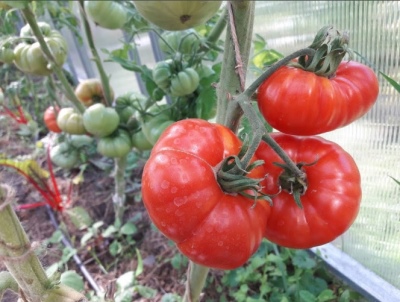
- Authors: Gavrish S.F., Morev V.V., Amcheslavskaya E.V., Degovtsova T.V., Volok O.A., Vasilyeva M. Yu. (LLC "Gavrish Breeding Firm")
- Year of approval: 2015
- Category: grade
- Growth type: indeterminate
- Appointment: fresh consumption, for pickling and preserving, for juice, for ketchup and tomato paste
- Ripening period: late ripening
- Ripening time, days: 110-115
- Growing conditions: for film greenhouses, for greenhouses
- Bush size: tall
- Bush height, cm: 150
Tomatoes The Cheerful Neighbor can indeed become pleasant companions for gardeners in the garden beds. But in order to get a good result, it is important to properly study this culture, and pay attention to its main nuances. It is worth figuring out how promising its cultivation is.
Breeding history
The "Gavrish" selection company, already widely known among farmers and summer residents, was engaged in the development of the tomato "Merry Neighbor". The plant was created by a whole team of specialists, including Amcheslavskaya, Volok, Gavrish and other masters of plant growing. The admission for cultivation in private gardens and plantations was given only in 2015. Therefore, the peculiarities of this culture are not yet sufficiently familiar to domestic gardeners.
Description of the variety
The cheerful neighbor is a typical indeterminate. Its bushes can grow up to 1.5 m. Elongated dark green leaves are formed on a powerful stem.
The main qualities of the fruit
Unripe tomatoes are light green in color; as it ripens, it is replaced by a red tone. A characteristic dark green spot is found near the very base. The berries are large, each weighing from 300 to 400 g. The fruits are flat in shape, the ribs on them are not too pronounced. There are 4 to 8 berries per brush.
Taste characteristics
Consumers note the classic tomato flavor. It is very rich, which pleases lovers of cooking. The flesh of the fruit is moderately firm. These properties allow the harvest to be used:
fresh;
as a raw material for canned vegetables;
to get juice;
for making ketchup or tomato paste.
Ripening and fruiting
The cheerful neighbor is a late-ripening plant. It usually takes from 110 to 115 days between the formation of seedlings and the achievement of readiness of the berries. The harvest takes place in July and August. In regions with short summers, this sometimes creates inconvenience.
Yield
The declared ability to collect from 8.8 to 9.5 kg per 1 sq. m. Therefore, the plant is considered a high-yielding crop. It should be noted that the normative fertility is achieved in film greenhouses. Outdoor cultivation can be a surprise. It is especially problematic in areas with sharply unstable spring and autumn weather.
The timing of planting seedlings and planting in the ground
The time to sow seeds in containers comes in March or April. Gardeners can determine the specific period themselves. Plants can be transplanted into film greenhouses (and under plastic cover) in April or May. Landing in open ground is allowed not earlier than the first days of June. In any case, it is necessary to monitor the weather very carefully.

Growing tomato seedlings is an extremely important process, because it largely depends on whether the gardener will be able to harvest at all. All aspects must be taken into account, from seedbed preparation to planting in the ground.
Landing scheme
Here they are guided by a simple rule of 400x600 mm. It is strongly not recommended to deviate from it. On average, 3-4 bushes are planted per 1 m2.Adding humus increases the chances of success.

Growing and care
There are the following recommendations here:
systematically weed the ground;
water weekly at the root;
feeding is carried out only at the root;
it is imperative to stepchild and form a culture;
in greenhouses it is worth using drip irrigation.




A plant needs different micronutrients at each stage of growth. All fertilizers can be divided into two groups: mineral and organic. Folk remedies are often used: iodine, yeast, bird droppings, eggshells.
It is important to observe the rate and period of feeding. This also applies to folk remedies and organic fertilizers.
Disease and pest resistance
Such a tomato can occasionally become ill with late blight. While this is unlikely, this formidable disease should be prevented as much as possible. Yellow leaves must be removed. The fight against infection is carried out with Bordeaux liquid. From branded drugs "Ordan" and "Fundazol" are effective; as for harmful insects, all those species are dangerous as for other varieties.


Resistant to adverse weather conditions
The cheerful neighbor is able to withstand the heat relatively well. In cold weather, it is also quite tenacious. However, it is categorically undesirable to abuse these properties of the plant. Experienced gardeners recommend helping him as soon as any problems are discovered.
Growing regions
The variety is zoned for:
north-west of the Russian Federation;
Primorsky and Khabarovsk Territories;
Tyumen, Novosibirsk, Kemerovo, Chita regions and Krasnoyarsk Territory;
other regions of Western and Eastern Siberia;
Ural regions;
Central Black Earth Region;
the entire Volga basin;
The North Caucasus;
center of the European part of the Russian Federation.
Review overview
In the assessments of consumers, the high fertility of the Merry Neighbor is noted above all. Externally, the bushes look beautiful. Gastronomically, there are no problems. Ripeness is not achieved very evenly. This discrepancy is especially pronounced in open gardens; greenhouse culture matures much more uniformly.

























































































